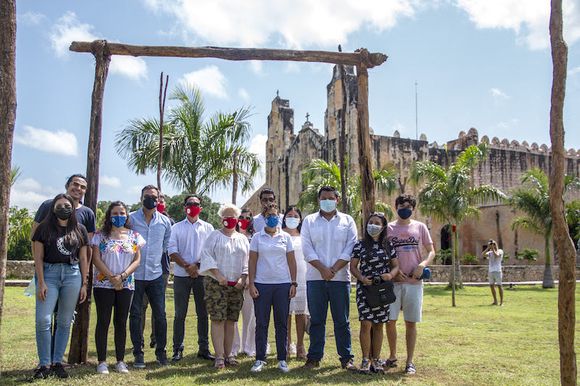Mérida, Yucatán, (July 31, 2021).- A dossier on the resilience of the Maya culture will be presented at the Italian Pavilion of the 17th Edition of the 2021 Venice Biennale International Architecture Exhibition, on September 25.
To this end, the Tourism Development Secretariat (Sefotur), in coordination with the LandWork Circus (LW Circus) of Italy and the Marista University of Mérida, carried out the “Mayalab” University Workshop, in order to compose said file.
Therefore, within the framework of the closing of the Workshop, a cooperation agreement was consolidated to make official the work carried out in the Magical Town of Maní, from July 23 to 29, 2021, as well as to continue with the actions and alliance between all the parts.
Work in Maní
During this time, the team made up of specialists from the LW Circus, the Marista University of Mérida, and the Sefotur, with the support of the Maní City Council and the Maya community of this town, carried out the fieldwork through an experimental methodology, studying the uses and customs.

They also studied vernacular architecture, in order to reflect on its resilience, as told by the residents and users themselves.
The result of the joint work will be exhibited in the “Art and Landscape” section, with the theme “Resilient landscapes for resilient communities”, in which Yucatán will represent Mexico, which participates together with China, India, and Italy in the Biennial of Architecture of Venice that, this year, has the name “How will we live together?”.
“Maní is one of the greatest examples of cultural and urban resilience after experiencing the Auto de Fe in 1562, which was the scene of one of the most complicated episodes for the Maya culture, but our resistance is alive, supported by our culture”, commented Mayor Aarón Interián Bojórquez, at the inauguration of the Workshop, via streaming with Venice, direct to the Italian Pavilion.
In this regard, Annacaterina Piras, president of the LW Circus Association, commented that “we really liked working with the memory of the place with which we have done all this research work these days. The main idea is based on making a triangulation between Asinara, Venice, and Maní, where we made the Venice Pavilion and the Resilient Communities Pavilion in Asinara, looking for a connection between them “.
“This exhibition is the physical representation of the investigation, adding to it a digital representation of everything collected through visits to the community and the participation of local inhabitants,” confirmed Piras.
To make up the contents of the Italian pavilion and as part of the experimental architecture workshop “Circus Maya Lab”, a proposal was made in Maní, Yucatán, based on research and popular consultation that ended in an installation based on bullfighting tables. in that ephemeral appropriation of space built by local communities.
Source: Sipse
TYT Newsroom


